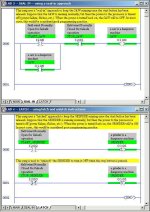Grover
Member
Greetings.
I am new to PLCs and this is my second post. I am researching an intermittent condition where the motor starts unexpectedly, which is obviously undesirable. We are using an AB SLC5-05. The VFD motor is controlled by a relay energized by O:14/9. This address is set (1) only once at rung 0026 and reset (0) once at address 0028 throughout the entire program.
I don't understand why the programmer put the XIC O:14/9 instruction in parallel with the timer done XIC 0026. Once the timer is done, the motor relay closes and should stay that way until rung 0028 goes true, right? Not shown is the previous rung for timer T4:15 which stays false.
A respected engineer in my group (respected = he knows more than I do) thought that if the rung for the OTL remains true, a subsequent OTU cannot effectively unlatch it. This doesn't seem right to me.
Any thoughts?
Grover
I am new to PLCs and this is my second post. I am researching an intermittent condition where the motor starts unexpectedly, which is obviously undesirable. We are using an AB SLC5-05. The VFD motor is controlled by a relay energized by O:14/9. This address is set (1) only once at rung 0026 and reset (0) once at address 0028 throughout the entire program.
I don't understand why the programmer put the XIC O:14/9 instruction in parallel with the timer done XIC 0026. Once the timer is done, the motor relay closes and should stay that way until rung 0028 goes true, right? Not shown is the previous rung for timer T4:15 which stays false.
A respected engineer in my group (respected = he knows more than I do) thought that if the rung for the OTL remains true, a subsequent OTU cannot effectively unlatch it. This doesn't seem right to me.
Any thoughts?
Grover
3-SEC ALL MOTOR
START INTLKS RELAY
DELAY CLOSED CLOSED
T4:15 B3:2 O:14
0026 ------] [--------] [----------[L]-------
| DN | 14 9
| |
| O:14 |
---] [---
9
STOP MOTOR MOTOR
MOTOR WINDOW RELAY
LATCH GOOD OPEN
B3:3 B3:2 O:14
0028 ------] [--------] [-----------------
10 6 9



